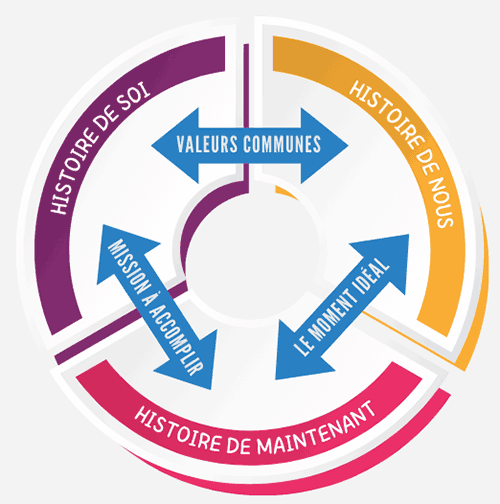
Pitch storytelling is the art of telling an inspiring story when you present yourself to someone or in front of an audience.
Why a story? To create a connection…
If stories resonate with us, it’s because they touch us. And for good reason, they bring us back to the difficulties (small and large) that we all encounter during our lives. We love learning about how others have lived and overcome their challenges, because it resonates with our own experiences. We then share each other’s emotions, their fears, their hopes and their doubts.
Marshall Ganzprofessor of communications at Harvard and strategist for Barack Obama’s first campaign, offers a 3-step narrative process, “Pitch storytelling”, to share your story in a sincere and inspiring way and allow your interlocutor to recognize and understand themselves. identify.
1. A story of yourself
To tell your personal story, you must start by sharing what motivated you to take action. Introduce yourself: who are you, what did you want to change and why?

Then, recount a challenge that you encountered in your professional career and explain how this difficulty pushed you to make the decision to change professionally: a lack of meaning, a need for something concrete, a tense situation, a change of life, the desire to flourish or to listen to yourself, or even the desire to reconnect with your values. Explain clearly what these values are and how they influenced your choice.
By sharing this story, you allow others to better understand and identify with you, which reinforces the emotional impact of your speech. Describe this “me” in two or three sentences.
2. A story about us
Why is your story about the person in front of you? Show how what you learned or what you want to do concerns her too. Link your personal story to an issue or a collective experience, to create a bond with this person: you can talk about their company, their sector or their profession.
Tell her why you want to join this collective story and identify with the values it defends. For example, you could say: “ Your company’s commitment echoes my convictions and my team spirit. This makes me want to join this ecosystem and make my contribution.“
By creating this connection, you will strengthen the impact of your speech. Describe this “we” in two or three sentences.
3. A story from now
What do you suggest now? What action do you want to take? You have created bonds with the person in front of you, and this third and final part of your story must focus on taking action. Think about what you can put in place in your professional project to act in accordance with the goals you share.
The “now” should clearly show how what you are proposing aligns with your values and goals common. How can we act together to achieve this result and how can we start now?
Describe this “now” in two or three sentences.
Find the link
The difficulty of Pitch storytelling is then to find the link between the three parts: the story of “me”, the story of “us” and the story of “now” form one and the same story.
Then, each time you present your pitch, you will have to adapt it to fit the person or audience you are speaking to. By developing your “we” story, you may be led to change your “me” story and your “now” story.
This storytelling pitch is therefore not a single “scenario”. Rather, it is a technique, a process through which you can reformulate your story again and again, according to your needs, wherever and whenever you want.
An example of a storytelling pitch
The following example is deliberately forced and caricatured to allow you to clearly understand the logic of how Pitch storytelling works based on the three stories.
Me : A few years ago, I faced a difficult situation at my job. My company denied the consequences of the plastic pollution caused by its production. This attitude went against my values. I decided to leave my job and embark on a project to help young entrepreneurs respect the environment in their activity.
We : I’m sure you’ve also had the opportunity to experience this type of pitfall in your professional life. We all share a common desire to create a more environmentally friendly world, for our children and for ourselves. By working together, we can help the next generation of entrepreneurs build start-ups that have a positive impact on society and the planet.
NOW : Now is the time to act. I suggest you join this movement and bring your means, your skills and your experience to support these young entrepreneurs. Together we can organize training and events to help them integrate respect for the environment into all their processes. We can start tomorrow by sharing our ideas and resources. I can even quickly set up an introductory workshop to raise awareness among your teams.

















